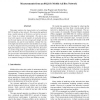Free Online Productivity Tools
i2Speak
i2Symbol
i2OCR
iTex2Img
iWeb2Print
iWeb2Shot
i2Type
iPdf2Split
iPdf2Merge
i2Bopomofo
i2Arabic
i2Style
i2Image
i2PDF
iLatex2Rtf
Sci2ools
WOWMOM
2006
ACM
2006
ACM
Measurements from an 802.11b Mobile Ad Hoc Network
This paper analyzes the characteristics of a multi-hop 802.11b mobile ad hoc network. We present data gathered from a mobile network of 20 devices carried by test users over 5 days in an indoor environment. The data is analyzed with regard to (i) the number of reachable devices, (ii) the node degree, (iii) the average path length, (iv) the link lifetime, (v) and the route lifetime. Despite the relatively high node density and low node mobility in our setup, we observe frequent network partitioning and considerably high path lengths (as large as 7 hops). However, the usability of these long paths is questionable as their lifetime is short. We believe that our measurements are representative for typical indoor environments and that the results can and should be used for evaluating networking protocols as well as to validate existing or to derive new mobility models.
| Added | 14 Jun 2010 |
| Updated | 14 Jun 2010 |
| Type | Conference |
| Year | 2006 |
| Where | WOWMOM |
| Authors | Vincent Lenders, Jorg Wagner, Martin May |
Comments (0)

